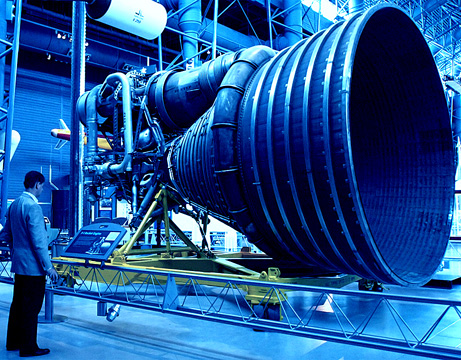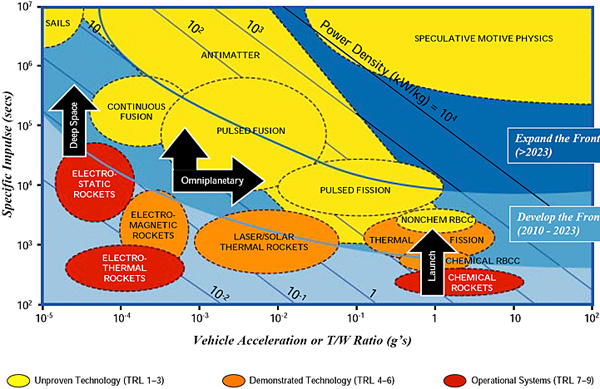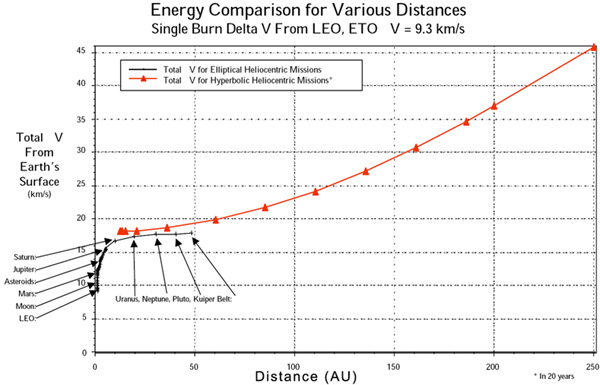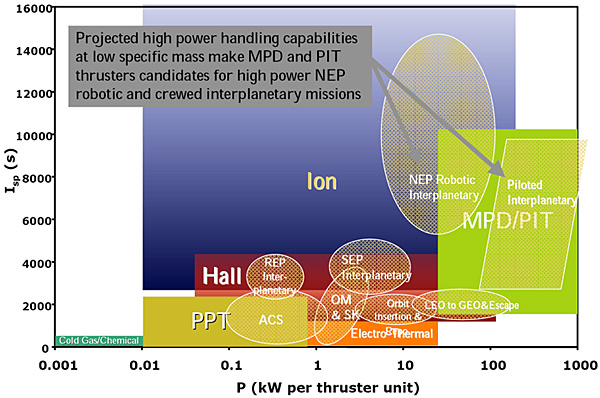Introduction

Here is your handy-dandy cheat-sheet of rocket engines. Without one of these, your spaceship ain't a spaceship. And if any smart-alec asks about a reactionless drive, it is atomic wedgie time.
Use this as a jumping-off point, there is no way I can keep this up-to-date. Google is your friend!
There are two types of engines, three if you count Torchships.
Muscle rocket engines have high thrust but low specific impulse, they burn rubber like nitro-fueled funny car with its buns on fire but the gas mileage sucks rocks through a garden hose. The fuel tanks will go empty in about ten minutes flat. Use these engines for blast off from a planet or when you gotta have high acceleration.Fuel Economy rocket engines have low thrust but high specific impulse, they push about as hard as asthmatic hummingbird but you can tool around the entire solar system with just a teacup of propellant. Use these for orbit-to-orbit flights where you are not in a hurry.
Some engines can shift gears, trading thrust for specific impulse and vicey versy also.
And Torchships break the rules by having both high thrust and high specific impulse. Everybody wants 'em but nobody has 'em. The only candidates on the horizon that might actually be built some day are the Orion Drive, Zubrin's Nuclear Salt Water Rocket, and maybe Medusa. Needless to say these are all poster children for Jon's Law.
I'll point out a few of the more useful items on the sheet:
- Aluminum-Oxygen is feeble, but is great for a lunar base (the raw materials are in the dirt).
- Microwave Electrothermal has low thrust. But it has great exhaust velocity, can use water propellant, is cheap, is simple, is reliable, is easily repaired, has reasonable power requirements, and you can cluster the blasted things to increase thrust without the little monsters interfering with each other.
- VASIMR is the current favorite among ion-drive fans. Use this with orbit-to-orbit ships that never land on a planet. It can "shift gears" like an automobile.
- Solar Moth might be a good emergency back-up engine.
- Nuclear Thermal Solid Core (an early "atomic rocket") is better than feeble chemical rockets, but not as much as you'd expect.
- Nuclear Thermal Vapor Core is what you design along the way while learning how to make a gas core atomic rocket.
- Nuclear Thermal Gas Core Open-Cycle is a full-blown honest-to-Heinlein atomic rocket, spraying glowing radioactive death in its exhaust.
- Nuclear Thermal Gas Core Closed-Cycle is an attempt to have the advantages of both nuclear solid core and gas core, but often has the disadvantages of both. It has about half the exhaust velocity of an open-cycle atomic rocket.
- Orion Nuclear Pulse is a rocket driven by detonating hundreds of nuclear bombs. If you can get past freaking out about the "bomb" part, it actually has many advantages. Don't miss the Medusa variant.
- Magneto Inertial Fusion This is the best fusion-power rocket design to date.
- Zubrin's Nuclear Salt Water This is the most over-the-top extreme rocket. Imagine a continuously detonating Orion drive. There are many scientist who question how the rocket can possibly survive turning the drive on.
But when it comes to high specific impulse engines, they generally all have incredibly low thrust. For purposes of comparison a hummingbird produces a thrust of about 0.05 newtons (47.3±5.5 mN). So the NSTAR ion drive used by the DAWN mission had a thrust of about 1.8 hummingbirds.
For more fun a snail can accelerate at about 0.008 m/s2, so the DAWN mission had an initial acceleration of about 0.00837 snails.
 Initial Notes
Initial Notes
There is a nice basic overview of propulsion systems here.
You can spend lots of time researching spacecraft propulsion systems. But you are in luck, I've got some data for you. This is from various places I found around the internet, and no, I didn't keep track of where I got them. Use at your own risk.
If you don't like the values in the table, do some research to see if you can discover values you like better. Also note that the designs in the list are probably optimized for high exhaust velocities at the expense of thrust. There is a chance that some can be altered to give enough thrust for lift-off at the expense of exhaust velocity. Or you can just give up and go beg Mr. Tyco Bass for some atomic tri-tetramethylbenzacarbonethylene. Four drops should do the trick.
Some engines require electricity in order to operate. These have their megawatt requirements listed under "Power Requirements". With these engines, the Engine Mass value includes the mass of the power plant (unless the value includes "+pp", which means the mass value does NOT include the mass of the power plant). The power plant mass can be omitted if the spacecraft relies on beamed power from a remote power station. Alas, I could find no figures on the mass of the power plant. If the plant is nuclear, it probably has a mass of around 0.5 to 10 tons per megawatt. If it is beamed power the mass is of course zero. Efficiency is the percentage of the power requirements megawatts that are actually turned into thrust. The rest becomes waste heat and has to be removed with heat radiators.
T/W >1.0 = Thrust to Weight ratio greater than one? This boils down to: can this engine be used to take off from Terra's surface? If the answer is "no" use it only for orbit to orbit maneuvers. It is calculated by figuring if the given thrust can accelerate the engine mass greater than one gee of acceleration. As a general rule, a practical spacecraft capable of lifting off from the Earth's surface will require a T/W of about 50 to 75.
 SUV class and Economy class
SUV class and Economy class
Most propulsion systems fall into two categories: SUV and economy. SUV propulsion is like an SUV automobile: big and muscular, but the blasted thing gets a pathetic three miles to the gallon. Economy propulsion has fantastic fuel economy, but has trouble climbing low hills. In the world of rockets, good fuel economy means a high "specific impulse" (Isp) and high exhaust velocity. And muscle means a high thrust.
The technical terms for SUV high-thrust + low-specific-impulse are Specific-Impulse Limited and High-Thrust Systems. Typical examples are chemical and solid-core nuclear thermal. These usually create the exhaust velocity by thermal means (heat), so they are limited by how hot you can get the exhaust (limited by chemical energy or limited by the melting point of the rocket engine).
The technical terms for Economy low-thrust + high-specific-impulse are Specific-Mass Limited, Low-Thrust Systems, and Power-Limited Systems. Typical example is an ion drive. "Specific Mass" or "Alpha" (α) is the mass of the propulsion system divided by the thrust power. These are usually electrically powered rockets, which is why they are power-limited.
The only vaguely possible propulsion system that has both high exhaust velocity and high thrust is the Nuclear Salt Water Rocket, and not a few scientist have questions about its feasibility. Well, actually there is also Project Orion, but that has other problems (see below). In science fiction, one often encounters the legendary "fusion drive" or "torchship", which is a high exhaust velocity + high thrust propulsion system that modern science isn't sure is even possible.

With ion engines, chemical engines, and nuclear torches we're facing a classic Newton's Third Law problem. Somehow the exhaust needs to have sufficient momentum for the opposite reaction to give the ship a good acceleration.
Chemical rockets solve the problem by expelling a ton of mass at a relatively low velocity. (high propellant mass flow but low exhaust velocity: SUV)
Ion drives expel a tiny amount of mass, so to get anywhere they get it moving FAST, but even at gigawatts of power they get a measly 0.0001g. (low propellant mass flow but high exhaust velocity: Economy)
Torch drives take a small-to-moderate amount of mass and use nuclear destruction to get it moving insanely fast. (medium propellant mass flow and high exhaust velocity: Torch) They're the only ones (insert disclaimer) with enough power per unit of reaction mass to get 0.3g constant acceleration conveniently. Even a perfect ion drive would need a phenomenal (read: impossible) amount of power input to match the performance of a nuclear explosion.
(A low propellant mass flow and low exhaust velocity engine would be utterly worthless)


(ed note: this is from the "Mass Driver" scifi universe featured in the Fate Space Toolkit role playing game)
Delta
The amount of acceleration needed to change one’s vector to a new, desired velocity. From the mathematical term Δv (“delta-vee”), meaning “change in velocity.” Also, figuratively, the amount of effort one needs to exert to avoid trouble, complications, or sticky situations. Grind Verb. To begin a change in delta. Used figuratively or literally. Grinda A space-rated engine, usually a VASIMR, capable of huge changes in delta, but which take, by greenbelt (groundhog) standards, a long time to complete the grind (low-thrust + high-specific-impulse). By extension, an individual who is either ploddingly slow or, conversely, incredibly patient in their ability to complete long-term machinations. Sparkle Verb. To emit or expose something to a harmful dose of radiation (a danger common to nuclear thermal rockets). Thumpa A chemical rocket engine, so called because it makes a loud rumble, pressing everyone backward for a short sound within the hab, then doesn’t make much change in delta (high-thrust + low-specific-impulse). Figuratively, anything or anyone who makes a lot of noise or causes a lot of harm, but doesn’t have much effect. (ed note: in this background, the wealthy corporations use grinda VASIMRs in their expensive spacecraft, while the dirt-poor asteroid miners use cranky radioactive nuclear thermal rockets in their broken-down mining ships. Nobody except teenagers or the desperate use thumpa chemical rockets)

The Drive Table
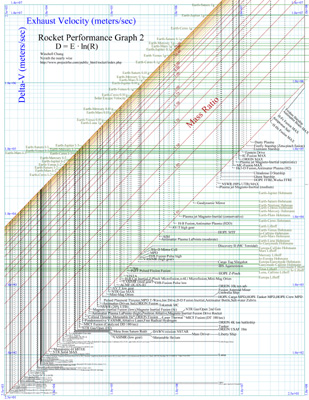
My handy-dandy Rocket Performance Graph
Download it here (version 2)
![]() Note that this table only contains engines for which I have data for the engine's thrust. There are a few for which I only have the specific impulse (e.g., Positron Ablative, LH2/Fluorine, Photon, etc.). These do not appear on the table but they have entries below.
Note that this table only contains engines for which I have data for the engine's thrust. There are a few for which I only have the specific impulse (e.g., Positron Ablative, LH2/Fluorine, Photon, etc.). These do not appear on the table but they have entries below.
All drives listed in the table whose names end in "MAX" require some sort of technological breakthrough to to prevent the engine from vaporizing and/or absurdly large reaction chamber sizes.
If these figures result in disappointing rocket performance, in the name of science fiction you can tweak some of them and claim it was due to a technological advance. You are allowed to tweak anything who's name does not end in "MAX". You can alter the Thrust, Engine Mass, and/or the Eff, but no other values. If there is a corresponding "MAX" entry for the engine you are tweaking, you cannot alter any of the values above the "MAX" entry (i.e., you are not allowed to tweak NTR-SOLID-DUMBO's thrust above 7,000,000, which is the value in the NTR-SOLID MAX entry).
The engines are sorted by thrust power, since that depends on both exhaust velocity and thrust. So engines that high in both of those parameters will be towards the end of the list. This is useful for designers trying to make spacecraft that can both blast-off from a planet's surface and do efficient orbital transfers.
As Philip Eklund noted in his game High Frontier, the engines fall into three rough categories: megawatt thrusters (thrust power), gigawatt thrusters, and terawatt thrusters. Though if you want to be pedantic the radioisotope, ArcJet, and HOPE MPD engines are kilowatt thrusters. The resistojet is a hectowatt thruster and the poor little DAWN NSTAR is a pathetic watt thruster.
If one was trying to design a more reasonable strictly orbit-to-orbit spacecraft one would want the engine list sorted by exhaust velocity. And surface-to-orbit designers would want the list sorted by thrust. Sorry, you'll have to do that yourself.
| Propulsion | Code | Thrust Power | Exhaust Velocity (m/s) | Specific Impulse (s) | Thrust (N) | Engine Mass (kg) | T/W |
|---|---|---|---|---|---|---|---|
| DAWN mission NSTAR | ESTAT | 1.37 W | 30,411 | 3,100 | 9.00e-05 | 26 | 3.60e-07 |
| Resistojet | ETHERM | 725 W | 2,900 | 296 | 1 | ||
| Radioisotope | NTR SOLID | 5.85 kW | 7,800 | 795 | 2 | ||
| ArcJet | ETHERM | 20 kW | 20,000 | 2,039 | 2 | ||
| HOPE Cargo MPD | EMAG | 432 kW | 78,500 | 8,002 | 11 | ||
| HOPE Tanker MPD | EMAG | 432 kW | 78,500 | 8,002 | 11 | ||
| START OF MEGAWATT THRUSTERS | |||||||
| Propulsion | Code | Thrust Power | Exhaust Velocity (m/s) | Specific Impulse (s) | Thrust (N) | Engine Mass (kg) | T/W |
| HOPE Crew MPD | EMAG | 1.1 MW | 78,500 | 8,002 | 28 | ||
| Magneto Inertial Fusion (low) | PULSE | 2.6 MW | 50,420 | 5,140 | 103 | ||
| VASIMR (low gear) | EMAG | 5.9 MW | 29,000 | 2,956 | 400 | 10,000 | 0.004 |
| VASIMR (high gear) | EMAG | 5.9 MW | 294,000 | 29,969 | 40 | 10,000 | 4.08e-04 |
| VASIMR (med gear) | EMAG | 5.8 MW | 147,000 | 14,985 | 80 | 10,000 | 8.15e-04 |
| Space Shuttle RCS | CHEM LIQ | 6.0 MW | 3,100 | 316 | 3,870 | 4 | 106.620 |
| Mirror Steamer | BEAM | 12.8 MW | 9,810 | 1,000 | 2,600 | 20,977 | 0.013 |
| Monatomic-H MITEE | NTR SOLID | 15.0 MW | 12,750 | 1,300 | 2,350 | 200 | 1.198 |
| HybridMITEE | ETHERM | 15.0 MW | 17,660 | 1,800 | 1,700 | 10,000 | 0.017 |
| Propulsion | Code | Thrust Power | Exhaust Velocity (m/s) | Specific Impulse (s) | Thrust (N) | Engine Mass (kg) | T/W |
| AIM | PULSE | 16.5 MW | 598,000 | 60,958 | 55 | ||
| Solar Moth | BEAM | 18.0 MW | 9,000 | 917 | 4,000 | 100 | 4.077 |
| Antimatter-Driven Sail | NTR FRAG | 19.5 MW | 73,600 | 7,500 | 530 | 109 | 0.496 |
| Umbrella Ship | ESTAT | 19.7 MW | 80,442 | 8,200 | 490 | ||
| ArcJet | ETHERM | 31.4 MW | 19,620 | 2,000 | 3,200 | 22,369 | 0.015 |
| Hall Effect | ESTAT | 32.4 MW | 19,620 | 2,000 | 3,300 | 85,469 | 0.004 |
| Magneto Inertial Fusion | PULSE | 36.0 MW | 49,000 | 4,995 | 1,470 | 9,100 | 0.016 |
| Pulsed Plasmoid Thruster | PULSE | 43.2 MW | 78,480 | 8,000 | 1,100 | 83,611 | 0.001 |
| Ponderomotive VASIMR | EMAG | 44.2 MW | 39,240 | 4,000 | 2,250 | 43,796 | 0.005 |
| Wakefield E-Beam | ETHERM | 45.1 MW | 19,620 | 2,000 | 4,600 | 41,837 | 0.011 |
| Ablative Laser | BEAM | 47.1 MW | 39,240 | 4,000 | 2,400 | 22,222 | 0.011 |
| MPD T-Wave | EMAG | 47.1 MW | 78,480 | 8,000 | 1,200 | 82,675 | 0.001 |
| Tungsten Resistojet | ETHERM | 48.6 MW | 9,810 | 1,000 | 9,900 | 42,601 | 0.024 |
| NASA space tug | CHEM LIQ | 49.3 MW | 4,400 | 449 | 22,400 | 199,600 | 0.011 |
| Mass Driver | OTHER | 51.0 MW | 9,810 | 1,000 | 10,400 | 163,000 | 0.007 |
| Ion Drive | ESTAT | 56.7 MW | 78,480 | 8,000 | 1,444 | 120,149 | 0.001 |
| MET Steamer Amplitrons | ETHERM | 58.9 MW | 9,810 | 1,000 | 12,000 | 123,302 | 0.010 |
| NERVA (CO or N2) | NTR SOLID | 64.9 MW | 2,649 | 270 | 49,000 | 10,000 | 0.499 |
| LPNTR High Gear | NTR SOLID | 65 MW | 13,200 | 1,350 | 9,800 | 835 | 1.2 |
| Basic MITEE | NTR SOLID | 68.7 MW | 9,810 | 1,000 | 14,000 | 200 | 7.136 |
| NERVA (CO2) | NTR SOLID | 81.0 MW | 3,306 | 337 | 49,000 | 10,000 | 0.499 |
| NERVA (H2O) | NTR SOLID | 99.0 MW | 4,042 | 412 | 49,000 | 10,000 | 0.499 |
| HOPE FFRE | NTR FRAG | 111.2 MW | 5,170,000 | 527,013 | 43 | ||
| Werka FFRE | NTR FRAG | 111.2 MW | 5,170,000 | 527,013 | 43 | 113,400 | 3.90e-05 |
| NERVA (NH3) | NTR SOLID | 125.0 MW | 5,101 | 520 | 49,000 | 10,000 | 0.499 |
| D-D Fusion Inertial | PULSE | 125.6 MW | 78,480 | 8,000 | 3,200 | 243,333 | 0.001 |
| NERVA (CH4) | NTR SOLID | 154.8 MW | 6,318 | 644 | 49,000 | 10,000 | 0.499 |
| Twisted Ribbon RD-0140 | NTR SOLID | 155.7 MW | 8,830 | 900 | 35,280 | 2,000 | 1.798 |
| Dusty Plasma (550AU) | NTR FRAG | 165.0 MW | 15,000,000 | 1,529,052 | 22 | 9,000 | 2.49e-04 |
| Propulsion | Code | Thrust Power (MW) | Exhaust Velocity (m/s) | Specific Impulse (s) | Thrust (N) | Engine Mass (kg) | T/W |
| Colloid Thruster | ESTAT | 172 | 43,000 | 4,383 | 8,000 | 20,000 | 0.041 |
| LARS | NTR LIQUID | 196 | 19,620 | 2,000 | 20,000 | 1,000 | 2.039 |
| NERVA (H2) | NTR SOLID | 198 | 8,093 | 825 | 49,000 | 10,000 | 0.499 |
| Laser Thermal | BEAM | 260 | 40,000 | 4,077 | 13,000 | 20,000 | 0.066 |
| LPNTR Low Gear | NTR SOLID | 292 | 11,900 | 1,210 | 49,000 | 835 | 6.0 |
| Mass Driver | OTHER | 300 | 30,000 | 3,058 | 20,000 | 150,000 | 0.014 |
| Twisted Ribbon NPPS | NTR SOLID | 307 | 9,024 | 920 | 68,000 | 1,800 | 3.851 |
| Lighter | CHEM LIQ | 309 | 4,410 | 450 | 140,000 | ||
| LANTR (high gear) | NTR SOLID | 309 | 9,221 | 940 | 67,000 | ||
| SNRE-class | NTR SOLID | 322 | 8,830 | 900 | 73,000 | 2,400 | 3.010 |
| Magneto Inertial Fusion (hi) | PULSE | 348 | 50,420 | 5,140 | 13,800 | ||
| H-B Cat Inertial | PULSE | 369 | 156,960 | 16,000 | 4,700 | 65,089 | 0.007 |
| Aluminum/LOX rocket | CHEM LIQ | 388 | 2,649 | 270 | 292,600 | 56,000 | 0.533 |
| NERVA (H) | NTR SOLID | 392 | 16,000 | 1,631 | 49,000 | 10,000 | 0.499 |
| MICF Fusion (cDD 100/sec) | FUSION | 423 | 36,300 | 3,700 | 23,300 | ||
| Kuck Mosquito | CHEM LIQ | 484 | 4,400 | 449 | 220,000 | ||
| Vortex Confined (H2) | NTR GAS OP | 494 | 19,620 | 2,000 | 50,400 | 114,116 | 0.045 |
| Pewee-class | NTR SOLID | 511.5 | 9,200 | 938 | 111,200 | 3,240 | 3.499 |
| LH2/LOX rocket | CHEM LIQ | 540 | 4,905 | 500 | 220,000 | 26,667 | 0.841 |
| VCR Light Bulb (H2) | NTR GAS CL | 553 | 19,620 | 2,000 | 56,400 | 72,566 | 0.079 |
| LANTR (low gear) | NTR SOLID | 584 | 6,347 | 647 | 184,000 | ||
| Dual-mode Fission (H2) | NTR SOLID | 612 | 9,810 | 1,000 | 124,700 | 33,000 | 0.385 |
| H-Li6 Fusor | FUSION | 658.3 | 19,620 | 2,000 | 67,100 | 54,000 | 0.127 |
| Cermet NERVA (H2) | NTR SOLID | 659 | 9,810 | 1,000 | 134,400 | 32,546 | 0.421 |
| Z-Pinch Microfission | PULSE | 667 | 156,960 | 16,000 | 8,500 | 193,333 | 0.004 |
| Afterburner FFRE | NTR FRAG | 730 | 313,900 | 32,000 | 4,651 | 268,961 | 0.002 |
| Dual-mode PB (H2) | NTR SOLID | 847 | 9,810 | 1,000 | 172,700 | 58,000 | 0.304 |
| Bimodal NTR Solid (NASA) | NTR SOLID | 898 | 8,980 | 915 | 200,000 | 6,672 | 3.056 |
| MICF Fusion (DT 100/sec) | FUSION | 911 | 44,200 | 4,500 | 41,200 | ||
| START OF GIGAWATT THRUSTERS | |||||||
| Propulsion | Code | Thrust Power (MW) | Exhaust Velocity (m/s) | Specific Impulse (s) | Thrust (N) | Engine Mass (kg) | T/W |
| Ion | ESTAT | 1,050 | 210,000 | 21,407 | 10,000 | 400,000 | 0.003 |
| D-T Fusion | FUSION | 1,188 | 22,000 | 2,243 | 108,000 | 10,000 | 1.101 |
| NERVA Deriv (H2) | NTR SOLID | 1,350 | 8,085 | 824 | 334,061 | 10,100 | 3.372 |
| Antimatter Bottle | PULSE | 1,362 | 78,480 | 8,000 | 34,700 | 180,000 | 0.020 |
| Metastable He* | CHEM | 1,376 | 43,000 | 4,383 | 64,000 | 10,000 | 0.652 |
| Resuable Nuclear Shuttle | NTR SOLID | 1,376 | 8,000 | 815 | 344,000 | ||
| Free Radical Hydrogen | 1,450 | 39,240 | 4,000 | 73,900 | |||
| Metastable Helium | CHEM | 1,567 | 29,430 | 3,000 | 106,500 | ||
| n-6Li Microfission | PULSE | 1,570 | 156,960 | 16,000 | 20,000 | 106,667 | 0.019 |
| Pebble Bed (H2) | NTR SOLID | 1,590 | 9,530 | 971 | 333,617 | 1,700 | 20.005 |
| Vapor Core (H2) | NTR VAPOR | 1,617 | 9,800 | 999 | 330,000 | 6,830 | 4.925 |
| Twisted ribbon NTR | NTR SOLID | 1,650 | 9,420 | 960 | 330,000 | 5,260 | 6.4 |
| 3He-D Mirror Cell | FUSION | 1,664 | 313,920 | 32,000 | 10,600 | 106,667 | 0.010 |
| HOPE MTF | FUSION | 2,005 | 691,460 | 70,490 | 5,798 | 116,021 | 0.005 |
| Cermet (H2) | NTR SOLID | 2,030 | 9,120 | 930 | 445,267 | 9,000 | 5.043 |
| D-T Fusion Tokamak | FUSION | 2,231 | 66,800 | 6,809 | 66,800 | 197,000 | 0.035 |
| Widmer Mars Mission | NTR SOLID | 2,320 | 8,000 | 815 | 580,000 | ||
| p-Nerva (NRX) | AM SOLID | 2,370 | 10,790 | 1,100 | 440,000 | 10,940 | 4.100 |
| Antimatter Solid max | AM SOLID | 2,374 | 10,791 | 1,100 | 440,000 | ||
| Dusty Plasma (0.5LY) | NTR FRAG | 2,580 | 15,000,000 | 1,529,052 | 344 | 9,000 | 0.004 |
| Proton RD-253 x1 | CHEM LIQ | 2,836 | 3,100 | 316 | 1,830,000 | 1,260 | 148.051 |
| PuFF Pulsed Fission Fusion | 2,880 | 196,000 | 19,980 | 29,400 | 55,560 | 0.054 | |
| Discovery II (MC Toroidal) | FUSION | 3,123 | 347,000 | 35,372 | 18,000 | ||
| Magnetoplasmadynamic | EMAG | 3,140 | 314,000 | 32,008 | 20,000 | 1,540,000 | 0.001 |
| HOPE Z-Pinch | PULSE | 3,617 | 189,780 | 19,346 | 38,120 | 95,138 | 0.041 |
| Raptor | CHEM LIQ | 3,714 | 3,730 | 380 | 1,993,000 | ||
| HELIOS 2nd Stage | NTR SOLID | 3,826 | 7,800 | 795 | 981,000 | ||
| NTR Gas/Closed (H2) | NTR GAS CL | 4,540 | 20,405 | 2,080 | 445,000 | 56,800 | 0.799 |
| Dumbo (CO or N2) | NTR SOLID | 4,636 | 2,649 | 270 | 3,500,000 | 5,000 | 71.356 |
| Atomic V-2 | NTR SOLID | 4,714 | 8,980 | 915 | 1,050,000 | 4,200 | 25.484 |
| Fusion Asteroid Miner | FUSION | 4,800 | 100,000 | 10,190 | 48,000 | 10,000 | 0.979 |
| ORION Fission | PULSE | 5,654 | 43,000 | 4,383 | 263,000 | 200,000 | 0.134 |
| Dumbo (CO2) | NTR SOLID | 5,786 | 3,306 | 337 | 3,500,000 | 5,000 | 71.356 |
| THS Fusion Pulse high gear | PULSE | 6,000 | 300,000 | 30,581 | 40,000 | 4,000 | 1.019 |
| THS Fusion Pulse low gear | PULSE | 6,000 | 150,000 | 15,291 | 80,000 | 4,000 | 2.039 |
| Propulsion | Code | Thrust Power (MW) | Exhaust Velocity (m/s) | Specific Impulse (s) | Thrust (N) | Engine Mass (kg) | T/W |
| Dumbo (H2O) | NTR SOLID | 7,074 | 4,042 | 412 | 3,500,000 | 5,000 | 71.356 |
| Antiproton Sail | NTR FRAG | 8,059 | 30,411,000 | 3,100,000 | 530 | ||
| Dumbo (NH3) | NTR SOLID | 8,927 | 5,101 | 520 | 3,500,000 | 5,000 | 71.356 |
| ORION Fusion | PULSE | 10,658 | 73,000 | 7,441 | 292,000 | 200,000 | 0.149 |
| Dumbo (CH4) | NTR SOLID | 11,056 | 6,318 | 644 | 3,500,000 | 5,000 | 71.356 |
| Saturn-V F-1 x1 | CHEM LIQ | 11,541 | 2,982 | 304 | 7,740,500 | 9,153 | 86.206 |
| ACMF (ICAN-II) | PULSE | 11,919 | 132,435 | 13,500 | 180,000 | 27,000 | 0.680 |
| Space Shuttle SSME x3 | CHEM LIQ | 12,115 | 4,444 | 453 | 5,452,200 | 9,531 | 58.313 |
| Dumbo (H2) | NTR SOLID | 14,163 | 8,093 | 825 | 3,500,000 | 5,000 | 71.356 |
| Solid rocket | CHEM SOLID | 15,000 | 3,000 | 306 | 10,000,000 | ||
| Proton RD-253 x6 | CHEM LIQ | 16,228 | 3,100 | 316 | 10,470,000 | 7,560 | 141.174 |
| VISTA | PULSE | 20,400 | 170,000 | 17,329 | 240,000 | ||
| Project Orion | PULSE | 21,731 | 19,620 | 2,000 | 2,215,200 | 203,680 | 1.109 |
| Nuclear DC-X NERVA | NTR SOLID | 27,272 | 9,810 | 1,000 | 5,560,000 | 199,600 | 2.840 |
| Dumbo (H) | NTR SOLID | 28,000 | 16,000 | 1,631 | 3,500,000 | 5,000 | 71.356 |
| Mini-Mag Orion (DRM-3) | PULSE | 29,853 | 93,000 | 9,480 | 642,000 | 199,600 | 0.328 |
| Antimatter Plasma (H2O) | AM PLASMA | 29,890 | 980,000 | 99,898 | 61,000 | 500,000 | 0.012 |
| H-B Fusion | FUSION | 29,890 | 980,000 | 99,898 | 61,000 | 300,000 | 0.021 |
| Mini-Mag Orion (DRM-1) | PULSE | 29,906 | 93,164 | 9,497 | 642,000 | 119,046 | 0.550 |
| APCP Space Shuttle SRB x2 | CHEM SOLID | 31,200 | 2,600 | 265 | 24,000,000 | 1,180,000 | 2.073 |
| ORION USAF 10m | PULSE | 32,900 | 32,900 | 3,354 | 2,000,000 | 107,900 | 1.889 |
| NTR Solid MAX | NTR SOLID | 42,000 | 12,000 | 1,223 | 7,000,000 | 15,000 | 47.571 |
| Gasdynamic Mirror | FUSION | 46,060 | 1,960,000 | 199,796 | 47,000 | ||
| Nuclear DC-X LANTR | NTR SOLID | 49,206 | 5,900 | 601 | 16,680,000 | 199,600 | 8.519 |
| NTR Liquid max | NTR GAS OP | 56,000 | 16,000 | 1,631 | 7,000,000 | 70,000 | 10.194 |
| Luna | NTR LIQUID | 56,650 | 10,300 | 1,050 | 11,000,000 | 9,000 | 124.589 |
| Propulsion | Code | Thrust Power (MW) | Exhaust Velocity (m/s) | Specific Impulse (s) | Thrust (N) | Engine Mass (kg) | T/W |
| Saturn-V F-1 x5 | CHEM LIQ | 58,054 | 3,000 | 306 | 38,702,500 | 45,765 | 86.206 |
| NTR Gas/Open (H2) | NTR GAS OP | 61,250 | 35,000 | 3,568 | 3,500,000 | 200,000 | 1.784 |
| Tanker | NTR GAS OP | 61,803 | 35,316 | 3,600 | 3,500,000 | ||
| AV:T high gear | PULSE | 102,138 | 832,928 | 84,906 | 245,250 | ||
| NTR Gas/Open 2nd Gen | NTR GAS OP | 125,000 | 50,000 | 5,097 | 5,000,000 | 200,000 | 2.548 |
| Mini-Mag Orion | PULSE | 146,795 | 157,000 | 16,004 | 1,870,000 | 199,600 | 0.955 |
| NTR Gas MAX | NTR GAS OP | 147,000 | 98,000 | 9,990 | 3,000,000 | 15,000 | 20.387 |
| NTR Gas/Coaxial (H2) | NTR GAS OP | 157,156 | 17,658 | 1,800 | 17,800,000 | 127,000 | 14.287 |
| Antimatter Plasma (H2) | AM PLASMA | 192,080 | 7,840,000 | 799,185 | 49,000 | 500,000 | 0.010 |
| He3-D Fusion | FUSION | 192,080 | 7,840,000 | 799,185 | 49,000 | 1,200,000 | 0.004 |
| MC-Fusion MAX | FUSION | 200,000 | 8,000,000 | 815,494 | 50,000 | 600 | 8.495 |
| P-jet MagnetoInertial (con) | FUSION | 309,350 | 1,189,790 | 121,280 | 520,000 | ||
| Salt-water Zubrin | NTR GAS OP | 341,266 | 78,480 | 8,000 | 8,696,900 | 495,467 | 1.789 |
| NSWR (20% UTB) | NTR GAS OP | 425,700 | 66,000 | 6,728 | 12,900,000 | 33,000 | 39.848 |
| FS Z-Pinch (p-11Be) | FUSION | 442,000 | 1,300,000 | 132,500 | 680,000 | ||
| Liberty Ship | NTR GAS CL | 560,700 | 30,000 | 3,058 | 37,380,000 | 378,000 | 10.080 |
| FS Z-Pinch (D-3He) | FUSION | 577,500 | 3,500,000 | 356,800 | 330,000 | ||
| Cargo Tug Slingshot | ESTAT | 764,400 | 280,000 | 28,542 | 5,460,000 | ||
| Start Of Terawatt Thrusters | |||||||
| Propulsion | Code | Thrust Power (MW) | Exhaust Velocity (m/s) | Specific Impulse (s) | Thrust (N) | Engine Mass (kg) | T/W |
| IBS Agamemnon | ESTAT | 1,100,000 | 220,000 | 22,426 | 10,000,000 | ||
| ORION battleship | PULSE | 1,560,000 | 39,000 | 3,976 | 80,000,000 | 1,700,000 | 4.797 |
| AV:T low gear | PULSE | 2,541,895 | 104,116 | 10,613 | 48,828,125 | ||
| P-jet MagnetoInertial (med) | FUSION | 2,989,051 | 4,461,270 | 454,770 | 1,340,000 | ||
| Ghost Starship | FUSION | 4,237,920 | 5,297,400 | 540,000 | 1,600,000 | ||
| Epstein Drive | FUSION | 5,500,000 | 11,000,000 | 1,100,000 | 1,000,000 | ||
| P-jet MagnetoInertial (opt) | FUSION | 7,941,000 | 8,922,480 | 909,530 | 1,780,000 | ||
| Firefly Starship (Z-Pinch) | FUSION | 12,245,500 | 12,890,000 | 1,313,970 | 1,900,000 | ||
| ORION 10k ton adv | PULSE | 24,000,000 | 120,000 | 12,232 | 400,000,000 | 3,250,000 | 12.546 |
| NSWR (90% UTB) MAX | NTR GAS OP | 30,550,000 | 4,700,000 | 479,103 | 13,000,000 | ||
| ORION MAX | PULSE | 39,200,000 | 9,800,000 | 998,981 | 8,000,000 | 8,000 | 101.937 |
| Enzmann Starship | FUSION | 343,570,500 | 11,700,000 | 1,192,700 | 58,730,000 | ||
| IC-Fusion MAX | PULSE | 500,000,000 | 10,000,000 | 1,019,368 | 100,000,000 | 1,000,000 | 10.194 |
| Antimatter Beam MAX | AM BEAM | 500,000,000 | 100,000,000 | 10,193,680 | 10,000,000 | 10,000 | 101.937 |
| Frisbee Starship | AM BEAM | 586,413,000 | 99,900,000 | 10,183,486 | 11,740,000 | ||
The details about each engine are on subsequent pages.
Electromagnetic (Plasma)
This section has been moved here
Electrodeless plasma
This section has been moved here
Helicon Double Layer (HDLT)
This section has been moved here
Magnetoplasmadynamic (MPD)
This section has been moved here
Pulsed Inductive (PIT)
This section has been moved here
Pulsed Plasma (PPT)
This section has been moved here
Pulsed Plasmoid
This section has been moved here
VASIMR
This section has been moved here
Electrostatic
This section has been moved here
Electrostatic Propellant
This section has been moved here
Colloid
This section has been moved here
Field-Emission Electric (FEEP)
This section has been moved here
Hall Effect (HET)
This section has been moved here
Ion
This section has been moved here
Radioisotope Electrostatic
This section has been moved here
( IBS Agamemnon )
This section has been moved here
Sail
This section has been moved here
Electric Sail
This section has been moved here
Magnetic Sail
This section has been moved here
M2P2
This section has been moved here
MagBeam
This section has been moved here
Photon Sail
This section has been moved here
Plasma Magnet
This section has been moved here
Q-Drive
This section has been moved here
Antimatter
This section has been moved here
Antimatter Energy
This section has been moved here
Radiation Shielding
This section has been moved here
Solid Core
This section has been moved here
Gas Core
This section has been moved here
Plasma Core
This section has been moved here
Antimatter Bottle
This section has been moved here
Beam Core
This section has been moved here
Positron Ablative
This section has been moved here
Fusion
This section has been moved here
Nuclear Magnetic Spin Alignment
This section has been moved here
( STARFIRE Fusion Afterburner )
This section has been moved here
( AV:T Fusion )
This section has been moved here
( THS Fusion Pulse )
This section has been moved here
( Epstein Drive )
This section has been moved here
Nuclear Thermal
This section has been moved here
Solid Core
This section has been moved here
NERVA
This section has been moved here
Pewee-class
This section has been moved here
SNRE-class
This section has been moved here
NERVA Derivative
This section has been moved here
DUMBO
This section has been moved here
Pebble Bed
This section has been moved here
Cermet
This section has been moved here
Pulsed Solid-core NTR
This section has been moved here
Project Timberwind
This section has been moved here
Russian Twisted Ribbon
This section has been moved here
Low Pressure NTR
This section has been moved here
LANTR
This section has been moved here
Bi-Modal NTR
This section has been moved here
Droplet Core
This section has been moved here
Vapor Core
This section has been moved here
Gas Core
This section has been moved here
Open Cycle
This section has been moved here
General Open Cycle
This section has been moved here
Hybrid-Fuel
This section has been moved here
Coaxial
This section has been moved here
Vortex Confined
This section has been moved here
Wheel Flow
This section has been moved here
Nuclear Salt Water
This section has been moved here
Watch the Heat
This section has been moved here
Popular Conceptions
This section has been moved here
